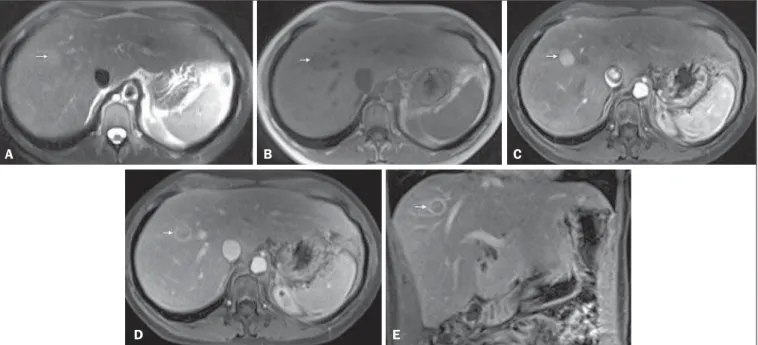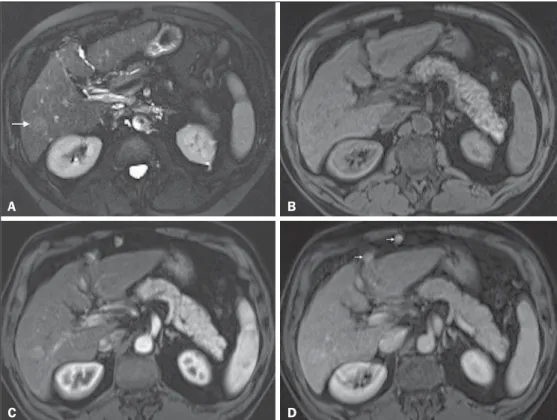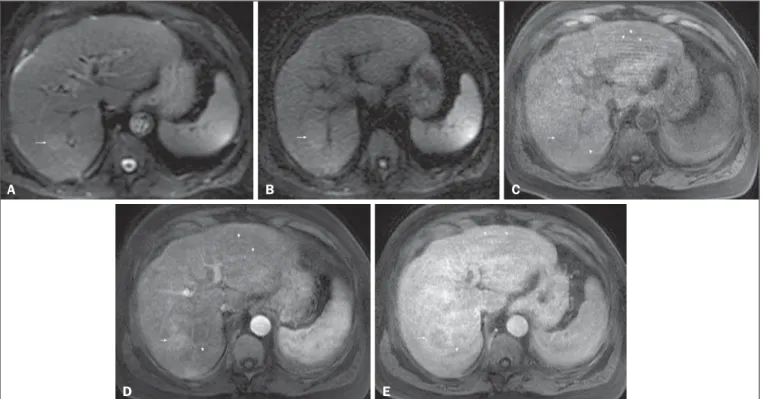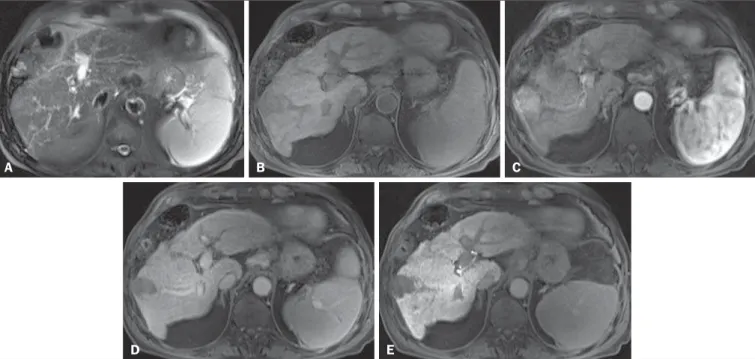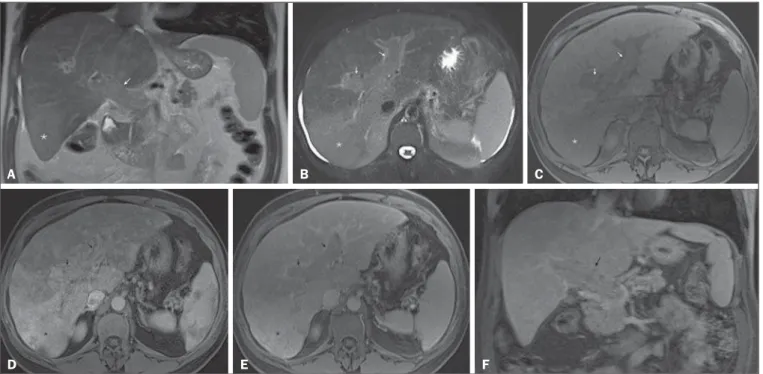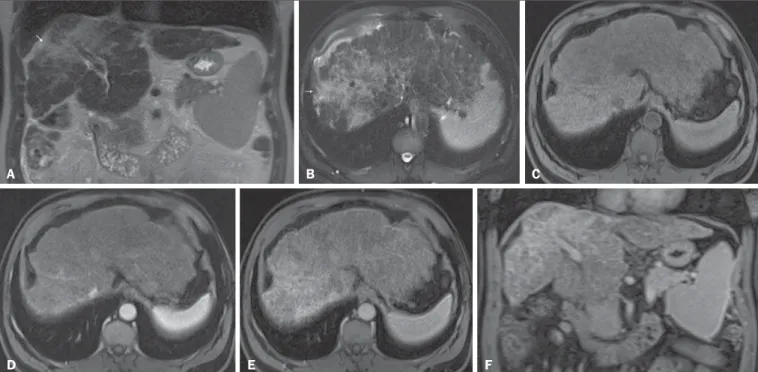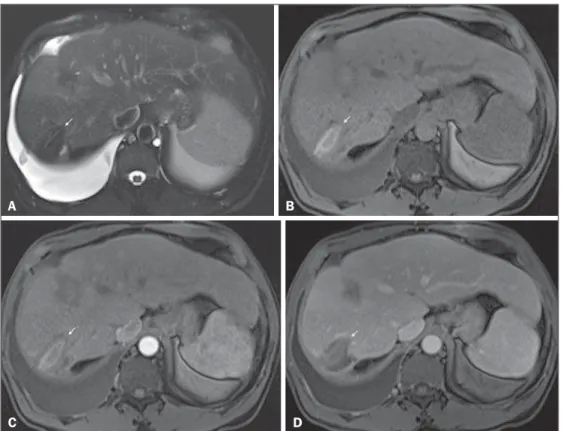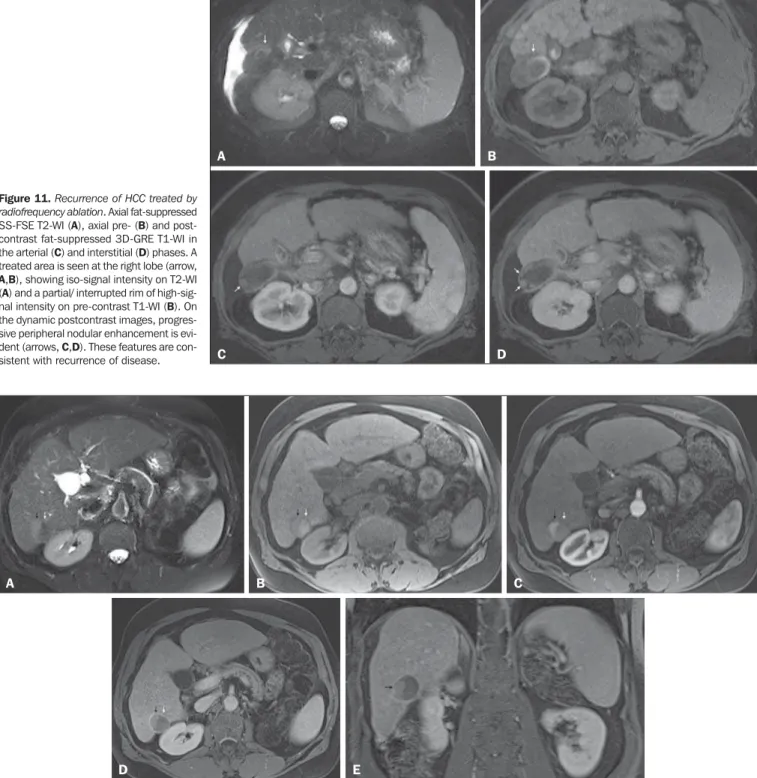Radiol Bras. 2017 Mar/Abr;50(2):115–125 115
Magnetic resonance imaging of the cirrhotic liver: diagnosis
of hepatocellular carcinoma and evaluation of response
to treatment – Part 2
Ressonância magnética do fígado cirrótico: diagnóstico de carcinoma hepatocelular e avaliação da resposta ao tratamento – Parte 2
Ramalho M, Matos AP, AlObaidy M, Velloni F, Altun E, Semelka RC. Magnetic resonance imaging of the cirrhotic liver: diagnosis of hepatocellular carcinoma and evaluation of response to treatment – Part 2. Radiol Bras. 2017 Mar/Abr;50(2):115–125.
Abstract
R e s u m o
In the second part of this review, we will describe the ancillary imaging features of hepatocellular carcinoma (HCC) that can be seen on standard magnetic resonance imaging (MRI) protocol, and on novel and emerging protocols such as diffusion weighted imaging and utilization of hepatocyte-specific/hepatobiliary contrast agent. We will also describe the morphologic sub-types of HCC, and give a simpli-fied non-invasive diagnostic algorithm for HCC, followed by a brief description of the liver imaging reporting and data system (LI-RADS), and MRI assessment of tumor response following locoregional therapy.
Keywords: Magnetic resonance imaging; Liver cirrhosis; Image enhancement; Contrast media.
Na segunda parte desta revisão descreveremos os achados de imagem auxiliares para o diagnóstico de carcinoma hepatocelular (CHC) e que podem ser observados num protocolo de ressonância magnética (RM) padrão e em protocolos emergentes que incluem imagens de difusão e aplicação de contrastes hepatoespecíficos/hepatobiliares. Descreveremos também os subtipos morfológicos de CHC e um algoritmo diagnóstico não invasivo simplificado para o CHC, seguido de uma breve descrição do liver imaging reporting and data system
(LI-RADS) e avaliação por RM após terapêutica locorregional.
Unitermos: Ressonância magnética; Cirrose hepática; Realce de imagem; Meio de contraste.
Study conducted in the Department of Radiology, University of North Carolina at Chapel Hill, Chapel Hill, NC, USA.
1. Department of Radiology, University of North Carolina at Chapel Hill, Chapel Hill, NC, USA, and Hospital Garcia de Orta, Almada, Portugal.
2. Department of Radiology, University of North Carolina at Chapel Hill, Chapel Hill, NC, USA, and King Faisal Specialist Hospital and Research Center, Riyadh, Saudi Arabia.
3. Department of Radiology, University of North Carolina at Chapel Hill, Chapel Hill, NC, USA.
Mailing address: Richard C. Semelka. University of North Carolina at Chapel Hill – Radiology. 101 Manning Drive, CB 7510 2001 Old Clinic Bldg, Chapel Hill, NC 27599-7510, USA. E-mail: richardsemelka@gmail.com.
Received July 16, 2015. Accepted after revision May 21, 2016.
none of them is specific of HCC in isolation, their presence increases the probability of HCC(1). Interestingly, most of these
features are depicted with magnetic resonance imaging (MRI). Delayed capsular enhancement is defined as a persistent peripheral hyper-enhancing rim seen in the delayed phase of enhancement (Figure 1), and could be helpful in lesions that do not show classical features of HCC on dynamic im-aging(2). Capsular enhancement has high specificity for HCC
reportedly ranging from 83–96%(3,4); however, sensitivity is
only moderate, ranging from 43–55%(3,4).
Intratumoral lipid is a relatively uncommon character-istic observed with HCC histologically (sensitivity for HCC of 12–37%)(3,5–8), and is more commonly present in the form
of intracellular lipid. Fatty metamorphosis may be identi-fied in a subset of cases with chemical shift imaging (Figure 2), in form of loss of signal intensity on the out-of-phase im-ages compared with the in-phase imim-ages. Conversely, lipid content is moderately specific for HCC (68–100%)(3,5–8) and
as stated above, any lipid-containing tumor in a cirrhotic liver should be viewed with suspicion, especially when the lesion is > 15 mm(8).
The appearance of HCC on T2-weighted images is vari-able. Mild to moderate T2 hyperintensity is highly sugges-tive of malignancy if present. Differential diagnosis includes: early HCC, progressed HCC, and intrahepatic cholangiocar-cinoma. The main limitation is the somewhat limited
sensi-Miguel Ramalho1, António P. Matos1, Mamdoh AlObaidy2, Fernanda Velloni3, Ersan Altun3, Richard C. Semelka3
ANCILLARY IMAGING FEATURES FOR THE DIAGNOSIS OF HEPATOCELLULAR CARCINOMA DEPICTED IN STANDARD PROTOCOL
Figure 1.Typical HCC in a patient with chronic hepatitis-C. Axial fat-suppressed SS-FSE T2-WI (A), axial in-phase precontrast (B) and postcontrast fat-suppressed 3D-GRE T1-WI in the arterial (C) and interstitial (D,E) phases. A nodule with 2 cm is depicted on the right hepatic lobe (arrows, A–E), showing mild high signal intensity on T2-WI (A) and low-signal intensity on pre-contrast T1-WI (B). On the dynamic postcontrast images, the lesion shows arterial hyper-enhancement (C) and delayed washout with pseudocapsule enhancement (D,E). These features are diagnostic of HCC.
A B C
D E
Figure 2. Fatty HCC in a patient with non-alcoholic fatty liver disease. Coronal SS-FSE T2-WI (A), axial fat-suppressed FSE T2-WI (B), axial in- (C) and out-of-phase (D) GRE T1-WI, axial pre- (E) and postcontrast fat-suppressed 3D-GRE T1-WI in the arterial (F) and interstitial (G) phases, and coronal fat-suppressed 3D-GRE T1-WI in the interstitial phase (H). One nodule is depicted on the left hepatic lobe (arrows, A–G), showing mild high signal intensity on T2-WI (A,B), low-signal intensity on in-phase T1-WI (C), and heterogeneous drop of signal on out-of-phase T1-WI (D). On the dynamic postcontrast images, the nodule is hypervascular (F) and shows delayed washout and pseudocapsule enhancement (G,H). Note the fine fibrotic bands of the liver parenchyma, which are seen at the late interstitial phase (arrowheads, G).
A B C
D E F
tivity for HCC, as many HCCs are T2 isointense or hypo-intense(9). HCCs tend to show minimal to mildly increased signal intensity on T2-weighted images with a specificity and a positive predictive value for HCC varying from 73–100% and 72–100%, respectively(3,5–7,10).
The elevated T2 signal in a focal lesion can be useful to reliably differentiate HCC from ndysplastic nodules (Fig-ure 3)(11). Recent studies have shown that the addition of
T2-weighted imaging to gadolinium-enhanced T1-T2-weighted 3D-GRE dynamic imaging improves the diagnostic performance of MRI in the detection of HCC compared to isolated dy-namic MRI. This is especially helpful for lesions smaller than 10 or 20 mm, which may show hypervascularity, but might not show any washout(12), increasing the suspicion for HCC(13) (Figure 3).
ANCILLARY IMAGING FEATURES FOR THE DIAGNOSIS OF HCC DEPICTED USING NOVEL AND EMERGING PRACTICES
Diffusion-weighted imaging (DWI)
DWI is an imaging technique based on differences in the Brownian motion (diffusion) of water molecules within tissues. In highly cellular tissues such as in tumors (and re-sultant compression of the extracellular spaces), the water molecules diffusion is restricted. Hence, signal hyperintensity within HCC relative to liver parenchyma is expected(14). The diffusion restriction can be confirmed by generating para-metric apparent diffusion coefficient (ADC) maps showing lower ADC values than the adjacent liver.
A limited number of studies have shown encouraging results suggesting that DWI has a good diagnostic
perfor-mance in the detection of HCC in patients with chronic liver disease and equivalent to conventional contrast-enhanced for lesions greater than 20 mm in size(15,16). Currently, the
limi-tation of DWI is primary lesion characterization rather than lesion detection(15,16).
The greatest benefit relies on the combined use of DWI with conventional dynamic MRI(17,18) (Figure 4). A recent
meta-analysis by Wu et al.(16) found that DWI combined with
conventional dynamic contrast-enhanced MRI performed significantly better than either DWI alone or conventional dynamic contrast-enhanced MRI alone (pooled sensitivity and specificity: 93% and 84% combined, 81% and 89% DWI, 79% and 62% dynamic contrast-enhanced ). Consequently, an additional acquisition of DWI is being implemented in abdominal protocols.
In a recent study, a new MRI criteria was proposed, com-bining the features of lesions after gadolinium-based con-trast media administration and hyperintensity on DWI(19). This significantly improved the sensitivity for the diagnosis of HCC compared to conventional hemodynamic criteria alone, irrespective of tumor size. However, additional larger studies are required to determine its role for the detection of HCC in patients with chronic liver diseases.
Hepatocyte-specific/hepatobiliary contrast agents MRI hepatobiliary contrast agents (HCAs) are shifting the paradigm of the diagnosis of HCC. Several recent stud-ies have investigated the use of the hepatobiliary phase of hepatocyte-specific contrast agents for diagnosing HCC with promising results(20,21). Two HCAs are currently available: gadoxetate disodium (Eovist®
/Primovist®
; Bayer Healthcare)
A B
C D
and gadobenate dimeglumine (MultiHance®
; Bracco Diag-nostics)(22). These two HCAs combine extracellular
proper-ties with liver-specific properproper-ties, allowing both dynamic and hepatobiliary imaging(23). Gadoxetic acid is more highly
liver-specific with approximately 50% of the injected dose taken up by functioning hepatocytes and is excreted in bile, allowing delayed uptake imaging within 20 min from the time of injection, compared with an uptake of 3–5% for gadobenate dimeglumine, which allows for delayed uptake imaging within 2–3 hours(22). It is worth noting that the
injection dose of gadoxetate disodium is smaller than that of extracellular gadolinium agents. This small dose can result in acquisition timing error and truncation artifacts in the arterial phase if not properly timed.
Using fluoroscopic triggering, with a low injection rate of 1 mL/s, to stretch the bolus or diluting the contrast with normal saline to 20 mL to enable a rapid injection rate at 2 mL/s are suggested solutions(24–26). Hepatobiliary phase
images are easy to recognize because both the liver and the bile ducts are markedly enhanced. The blood vessels as well as all non-hepatocellular lesions and lesions with impaired hepatocytes all appear hypointense. Typically, HCCs exhibit hypointensity on hepatobiliary phase images (Figure 5), except for some well-differentiated HCCs that may retain contrast.
The combination of routine dynamic and hepatobiliary imaging has been reported to be both sensitive and specific for HCC (sensitivity, 67–97%; specificity, 83–98%)(5,7,27–33).
Two recent meta-analyses found a pooled sensitivity of 91% and specificity of 93%(21,34). The addition of hepatobiliary
phase images improves the per-lesion sensitivity for the di-agnosis of HCC by 6–15% for gadoxetate acid(28,35,36) and
by 9% for gadobenate dimeglumine(37).
Gadoxetic acid-enhanced MRI has numerous advantages in imaging the cirrhotic liver including: i) higher sensitivity for the diagnosis of HCC, especially for lesions ≤ 20 mm (Figure 6)(28,35,38,39); ii) improved characterization of
arte-rially enhancing lesions without definite washout on subse-quent imaging (Figure 6)(33,35); iii) distinguishing arterially
enhancing pseudo-lesions from HCC(33); and iv) detection
of lesions that are isointense to the background hepatic pa-renchyma on all sequences, apart from the hepatobiliary phase, that are at high risk of transforming to hypervascular HCC(40,41). Nodules that show hypointensity on the
hepato-biliary phase, but lacking diagnostic features of HCC on the earlier post-contrast phases may represent high-grade dys-plastic nodules or early HCC(6,7,42), and are at increased risk
of progression to invasive hypervascular HCC.
Morphologic HCC sub-types
HCCs can manifest as: i) focal (nodular); ii) massive; and iii) diffuse/infiltrative(43). Nodular type is the most com-mon encountered type and can be further classified as soli-tary or multi-focal. Multi-focal nodular subtype is an ad-vanced and aggressive subtype and shows similar features to solitary nodular subtype on conventional and dynamic MRI.
Figure 4.HCC in a patient with chronic hepatitis-C unable to fully cooperate with the recommended breath-holds on the dynamic GRE sequences. Axial DWI b = 50 s/m2 (A) and DWI b = 600 s/m2 (B), axial pre- (C) and postcontrast fat-suppressed 3D-GRE T1-WI in the arterial (D) and interstitial (E) phases. One nodule on the right hepatic lobe is depicted (arrow, A–E), showing mild high-signal intensity on DWI (A,B). On the dynamic postcontrast images, the lesion shows arterial hyper-enhance-ment (D), and shows delayed washout and pseudocapsule enhancement (E). Note that the diagnosis of HCC is confident, despite the low quality images due to respiratory motion artifacts (arrowheads, C–E).
A B C
Additional features that are relatively uncommon with soli-tary focal lesions, but are noticed with multi-focal HCC and other aggressive subtypes include portal venous thrombosis and in intrahepatic metastases(43). Massive tumors are large
tumors that often render these patients non-eligible for
locoregional ablative therapies or hepatic transplantation. Diffuse HCCs are usually large and have ill-defined bound-aries without clear demarcation. They usually present with extremely high alpha-fetoprotein levels and are invariably associated with portal venous thrombus, which is almost
A B C
D E
Figure 5.HCC evaluated using gadoxetate disodium (hepatobiliary contrast agent). Axial fat-suppressed (A) SS-FSE T2-WI, axial pre- (B) and postgadolinium (gadoxetate disodium) fat-suppressed 3D-GRE T1-WI in the arterial (C), interstitial (D) and hepatobiliary phases (E). An HCC is depicted in the right liver lobe, in a background cirrhotic parenchyma, showing mild high signal intensity on T2-WI, low signal intensity on T1-WI, hypervascular characteristics (C) and washout on the delayed phase (D). On the hepatobiliary phase, due to the presence of impaired hepatocytes, the HCC shows no enhancement (E). Note the enhancement of the biliary duct (arrowheads, E).
A B C
D E
Figure 6. Small HCC diagnosed using gadoxetate disodium (hepatobiliary contrast agent). Axial fat-suppressed (A) SS-FSE T2-WI, axial pre- (B) and postgadolinium (gadoxetate disodium) fat-suppressed 3D-GRE T1-WI in the arterial (C), interstitial (D) and hepatobiliary phases (E). A small HCC is depicted in the right liver lobe, medial to the right hepatic vein, showing isointensity on T2-WI, mild low signal intensity on T1-WI, arterial hyper-enhancement (C) and no perceptible washout on the delayed phase (D). On the hepatobiliary phase, due to the presence of impaired hepatocytes, the HCC shows no enhancement (arrow, E). This case exemplifies the advantages of hepatobiliary contrast agents in the characterization of liver nodules in the setting of cirrhosis.
Figure 7. Diffuse HCC in a patient with chronic hepatitis C. Coronal SS-FSE T2-WI (A), axial fat-suppressed SS-FSE T2-WI (B), axial pre- (C) and postcontrast fat-suppressed 3D-GRE T1-WI in the arterial (D) and interstitial (E) phases, and coronal postcontrast fat-suppressed 3D-GRE T1-WI in the interstitial phase (F). A diffuse area of mild high-signal intensity on T2-WI (asterisk, A,B) is depicted on the right liver lobe, showing low-signal intensity on pre-contrast T1-WI (C). On the dynamic postcontrast images, the lesion is hypervascular at the arterial phase (D) and shows delayed heterogeneous mottled washout (E,F). These features are diagnostic of diffuse HCC. Note the tumor thrombus filling and expanding the portal vein, typical of this type of HCC (arrows, A–F). The thrombus shows hypervascular characteristics and delayed washout comparable to the MRI dynamic features of the tumor.
A B C
D E F
always tumoral in nature. Diffuse HCCs can be extremely subtle, and therefore challenging to reach an early diagno-sis as they can blend with the background liver parenchyma. Kneuertz et al.(43) evaluated 147 patients with advanced HCCs
(75 with infiltrative HCC and 72 patients with multi-focal HCC). In that study, failure to exhibit a distinct mass was observed in 42.7% of patients, whereas low T1 signal inten-sity was observed in 55.7% and high T2 signal inteninten-sity was observed in 80.3% of patients. They also showed mild mil-iary pattern of enhancement on the arterial phase imaging in 16.4% of patients, with delayed washout in 50.8% (Fig-ure 7). In clinical practice, it has to be differentiated from areas of confluent fibrosis. Post-contrast delayed imaging is crucial as it demonstrates heterogeneous washout in diffuse HCC(44), whereas confluent fibrosis shows increase enhance-ment over time (Figure 8). Another distinctive feature from confluent fibrosis is the presence of regional tumor throm-bus that is almost invariably present in patients with diffuse HCC and uncommon in confluent fibrosis(45).
A rare variant of nodular morphologic subtype is arteri-ally rim-enhanced HCC. These tumors tend to present a more aggressive behavior with rapid interval growth and disease worsening(46).
Simplified schematic representation of focal lesions in the cirrhotic liver
A simplified schematic representation of the typical im-aging features of the most common cirrhotic lesions is pro-vided in Figure 9.
Liver imaging reporting and data system (LI-RADS) LI-RADS is an initiative supported and developed by the American College of Radiology (ACR)(47) to improve
ter-minology standardization and consensus for interpreting and reporting imaging findings of the liver in patients with cir-rhosis or in at-risk for HCC. It has been developed to pro-vide a framework for assigning degrees of concern on imag-ing findimag-ings, improvimag-ing communication with clinicians, and facilitating decision making and outcome monitoring(48).
This evolving comprehensive document can be accessed online at the ACR website(47). A detailed summary of
LI-RADS is beyond the scope of this article.
The LI-RADS classifies lesions into five categories rang-ing from definitely benign to definitely HCC: LR-1 (defi-nitely benign); LR-2 (probably benign); LR-3 (indeterminate probability of HCC); LR-4 (probably HCC); LR-5 (definitely HCC); and LR-M (other malignancy such as cholangiocar-cinoma).
Figure 8. Liver cirrhosis with confluent fibrosis. Coronal (A) and axial fat-suppressed (B) SS-FSE T2-WI, axial pre- (C) and postcontrast fat-suppressed 3D-GRE T1-WI in the arterial (D) and interstitial (E) phases, and coronal postcontrast fat-suppressed 3D-GRE T1-WI in the interstitial phase (F). There is a linear pattern of fibrosis throughout the liver, with a focal region of confluent fibrosis in segments 7 and 8 peripherally (arrow, A,B), that is moderately high in signal on T2-WI (A,B) and mildly low in signal on T1-weighted image (C) and demonstrates negligible enhancement on early postcontrast image (D) and moderate enhancement on delayed image (E,F). The fine pattern of fibrosis is better depicted on late postgadolinium images as linear enhancing structures (E,F). Note the distorted anatomy and capsular retraction of segment 7, in relation to the more prominent region of fibrosis. The absence of portal vein thrombus, lack of arterial hyper-enhancement and delayed progressive enhancement allows the confident diagnosis of confluent fibrosis and excludes diffuse HCC.
F E
D
A B C
interval (short-time follow-up), or repeat imaging using a different method (alternative imaging), and/or engage in multi-disciplinary discussion(48).
Figure 9.Stereotypical simplified schematic representation, showing MRI features of cirrhotic nodules. In this schematic representation it is shown the appearance of common hepatocellular nodules in the cirrhotic liver, using a standard abdominal protocol. Abbreviations: HCC, hepatocellular carcinoma; HGDN, high grade dysplastic nodule; FS T2-WI, suppressed T2-weighted image; T1-WI IP, T1-weighted in-phase image; T1-WI OP, T1-weighted out-of-phase image; T1-WI AP, post-contrast fat-suppressed T1-weighted image at the late arterial phase; T1-WI PVP, contrast fat-fat-suppressed T1-weighted image at the portal-venous phase; T1-WI Inter P, post-contrast fat-suppressed T1-weighted image at the interstitial phase; T1-WI HBP, post-post-contrast fat-suppressed T1-weighted image at the hepatobiliary phase (with hepatobiliary contrast agent).
In the absence of typical enhancement features, ancil-lary features suspicious for malignancy, such as high T2 signal intensity, restricted diffusion, intra-lesional fat, hypointensity on hepatobiliary phase, can be used to upgrade a nodule to LR-4 (probably HCC), but not to LR-5 (definitely HCC). On the other hand, ancillary features that favor benignity can also be used to downgrade the LR category.
There is a tendency of incorporating HCA in the evalu-ation of cirrhotic patients(50) and the latest LI-RADS version
added it as an ancillary feature(47). A recent study from Chen
et al.(51) evaluated the value of hypointensity on hepatobiliary phase imaging of gadoxetic acid in the 2014 version of the LI-RADS. They showed that the use of hepatobiliary phase imaging from gadoxetic acid as an additional criteria im-proved the sensitivity of LI-RADS to distinguish HCCs from benign hepatic lesions, while maintaining high specificity.
Assessment of tumor response on MRI after locoregional therapy
With increasing comorbidities associated with patients with cirrhosis, there has been an evolution of minimally in-vasive approaches to treat HCCs. Percutaneous and laparo-scopic radiofrequency ablation and microwave ablation are thermoablative therapies that are now widely used to treat
the only treatment that has proved to extend life expect-ancy(55). Regardless of the treatment modality, the best
indi-cator of successful ablation is the absence of enhancement on postcontrast images (Figure 10)(56). Due to its high soft
tissue contrast and high sensitivity to intravenous gadolinium-based contrast agents, MRI plays an important role in the evaluation of therapeutic response of HCC following abla-tive techniques (Figure 11). The ablation cavity occasion-ally appears T1 hyperintense and subtracted images better show the presence or absence of enhancement in this instance. Although a thin, smooth rim of hyperemic reactive tissue persists around the ablated cavity for several months, nodu-lar or mass-like internal or perilesional enhancement sug-gests residual or recurrent tumor(56) (Figure 12). It should
be noted that following thermoablation procedures, residual or recurrent tumor might not hyper-enhance on the first 2 months after treatment(57); however, hyper-enhancement
usually occurs on subsequent MRIs. Lack of hyperintensity on DWI and evidence of regression of restricted diffusion on ADC maps supports successful tumor ablation(58).
CONCLUSION
MRI is the mainstay of noninvasive evaluation of the cir-rhotic liver. The sensitivity of arterial phase
hyper-enhance-Figure 10.Post-microwave ablation of HCC in a patient with chronic hepatitis C. Axial fat-suppressed SS-FSE T2-WI (A), axial pre- (B) and postcontrast fat-sup-pressed 3D-GRE T1-WI in the arterial (C) and interstitial (D) phases. The treated area is seen on the right hepatic lobe (ar-row, A–D), showing low-signal intensity on T2-WI (A) and a rim of high-signal inten-sity on pre-contrast T1-WI (B). On dynamic postcontrast images, the treated lesion shows no enhancement along all post-contrast dynamic phases (C,D), i.e., the high-signal intensity rim is identical to that shown on unenhanced image (B), so it represents persistent high intrinsic T1 signal rather than enhancement. This fea-ture is consistent with absence of residual viable neoplasm.
D B A
ment and delayed washout is recognizable relatively low for HCCs < 20 mm. In the second part of this review, we de-scribed new techniques and the utilization of hepatobiliary contrast agents along with the ancillary MR imaging features that appear to improve the sensitivity of HCC detection, which may potentially modify patients’ management.
MRI has been shown to be superior to CT, not only in the diagnosis of HCC, but also in the assessment of tumor response following therapy. In this review, we shortly de-scribed the most important MRI aspects that radiologist should be aware of when assessing tumor response after locoregional therapy.
Figure 11.Recurrence of HCC treated by radiofrequency ablation. Axial fat-suppressed SS-FSE T2-WI (A), axial pre- (B) and post-contrast fat-suppressed 3D-GRE T1-WI in the arterial (C) and interstitial (D) phases. A treated area is seen at the right lobe (arrow,
A,B), showing iso-signal intensity on T2-WI (A) and a partial/ interrupted rim of high-sig-nal intensity on pre-contrast T1-WI (B). On the dynamic postcontrast images, progres-sive peripheral nodular enhancement is evi-dent (arrows, C,D). These features are
con-sistent with recurrence of disease. D
B A
C
Figure 12.Recurrence of HCC after chemoembolization. Axial fat-suppressed SS-FSE T2-WI (A), axial pre- (B) and postcontrast fat-suppressed 3D-GRE T1-WI in the arterial (C) and interstitial (D) phases, and coronal postcontrast fat-suppressed 3D-GRE T1-WI in the interstitial phase (E). A treated area post-TACE is seen in the right liver lobe (arrows, A–E), showing heterogeneous intensity on T2-WI, with areas of moderate high-signal (black arrow, A) and low-signal (white arrow, A) intensity. These same areas show low-signal (black arrow, B) and high-signal (white arrow, B) intensity on precontrast T1-WI, respectively. On the dynamic postcontrast images, the areas of high-signal T2-WI are hypervascular (black arrow, C) and show washout and pseudocapsule on interstitial phase (black arrow, D,E), consistent with residual/ recurrent HCC. The medial aspect showed no signs of recurrence.
A B C
hepatocellular carcinoma ≤ 2 cm in cirrhosis. Diagnostic accuracy assessing fat, capsule and signal intensity at dynamic MRI. J Hepatol. 2012;56:1317–23.
4. Khan AS, Hussain HK, Johnson TD, et al. Value of delayed hypoin-tensity and delayed enhancing rim in magnetic resonance imaging diagnosis of small hepatocellular carcinoma in the cirrhotic liver. J Magn Reson Imaging. 2010;32:360–6.
5. Kim TK, Lee KH, Jang HJ, et al. Analysis of gadobenate dimeglu-mine-enhanced MR findings for characterizing small (1-2-cm) he-patic nodules in patients at high risk for hepatocellular carcinoma. Radiology. 2011;259:730–8.
6. Quaia E, De Paoli L, Pizzolato R, et al. Predictors of dysplastic nod-ule diagnosis in patients with liver cirrhosis on unenhanced and gadobenate dimeglumine-enhanced MRI with dynamic and hepato-biliary phase. AJR Am J Roentgenol. 2013;200:553–62.
7. Sano K, Ichikawa T, Motosugi U, et al. Imaging study of early hepatocellular carcinoma: usefulness of gadoxetic acid-enhanced MR imaging. Radiology. 2011;261:834–44.
8. Yu JS, Chung JJ, Kim JH, et al. Fat-containing nodules in the cir-rhotic liver: chemical shift MRI features and clinical implications. AJR Am J Roentgenol. 2007;188:1009–16.
9. Choi JY, Lee JM, Sirlin CB. CT and MR imaging diagnosis and staging of hepatocellular carcinoma: part II. Extracellular agents, hepatobiliary agents, and ancillary imaging features. Radiology. 2014;273:30–50.
10. Hussain HK, Syed I, Nghiem HV, et al. T2-weighted MR imaging in the assessment of cirrhotic liver. Radiology. 2004;230:637–44. 11. Arif-Tiwari H, Kalb B, Chundru S, et al. MRI of hepatocellular carcinoma: an update of current practices. Diagn Interv Radiol. 2014;20:209–21.
12. Forner A, Vilana R, Ayuso C, et al. Diagnosis of hepatic nodules 20 mm or smaller in cirrhosis: prospective validation of the noninvasive diagnostic criteria for hepatocellular carcinoma. Hepatology. 2008; 47:97–104.
13. Guo L, Liang C, Yu T, et al. 3 T MRI of hepatocellular carcinomas in patients with cirrhosis: does T2-weighted imaging provide added value? Clin Radiol. 2012;67:319–28.
14. Taouli B, Koh DM. Diffusion-weighted MR imaging of the liver. Radiology. 2010;254:47–66.
15. Piana G, Trinquart L, Meskine N, et al. New MR imaging criteria with a diffusion-weighted sequence for the diagnosis of hepatocellu-lar carcinoma in chronic liver diseases. J Hepatol. 2011;55:126–32. 16. Wu LM, Xu JR, Lu Q, et al. A pooled analysis of diffusion-weighted imaging in the diagnosis of hepatocellular carcinoma in chronic liver diseases. J Gastroenterol Hepatol. 2013;28:227–34.
17. Xu PJ, Yan FH, Wang JH, et al. Contribution of diffusion-weighted magnetic resonance imaging in the characterization of hepatocellu-lar carcinomas and dysplastic nodules in cirrhotic liver. J Comput Assist Tomogr. 2010;34:506–12.
18. Xu PJ, Yan FH, Wang JH, et al. Added value of breathhold diffu-sion-weighted MRI in detection of small hepatocellular carcinoma lesions compared with dynamic contrast-enhanced MRI alone us-ing receiver operatus-ing characteristic curve analysis. J Magn Reson Imaging. 2009;29:341–9.
19. Sandrasegaran K, Tahir B, Patel A, et al. The usefulness of diffu-sion-weighted imaging in the characterization of liver lesions in patients with cirrhosis. Clin Radiol. 2013;68:708–15.
opment and applications. Eur Radiol. 2004;14:559–78.
23. Bormann RL, da Rocha EL, Kierzenbaum ML, et al. The role of gadoxetic acid as a paramagnetic contrast medium in the character-ization and detection of focal liver lesions: a review. Radiol Bras. 2015;48:43–51.
24. Van Beers BE, Pastor CM, Hussain HK. Primovist, Eovist: what to expect? J Hepatol. 2012;57:421–9.
25. Zech CJ, Vos B, Nordell A, et al. Vascular enhancement in early dynamic liver MR imaging in an animal model: comparison of two injection regimen and two different doses Gd-EOB-DTPA (gado-xetic acid) with standard Gd-DTPA. Invest Radiol. 2009;44:305– 10.
26. Haradome H, Grazioli L, Tsunoo M, et al. Can MR fluoroscopic triggering technique and slow rate injection provide appropriate arterial phase images with reducing artifacts on gadoxetic acid-DTPA (Gd-EOB-acid-DTPA)-enhanced hepatic MR imaging? J Magn Reson Imaging. 2010;32:334–40.
27. Park MJ, Kim YK, Lee MW, et al. Small hepatocellular carcinomas: improved sensitivity by combining gadoxetic acid-enhanced and diffusion-weighted MR imaging patterns. Radiology. 2012;264: 761–70.
28. Ahn SS, Kim MJ, Lim JS, et al. Added value of gadoxetic acid-en-hanced hepatobiliary phase MR imaging in the diagnosis of hepato-cellular carcinoma. Radiology. 2010;255:459–66.
29. Akai H, Kiryu S, Matsuda I, et al. Detection of hepatocellular car-cinoma by Gd-EOB-DTPA-enhanced liver MRI: comparison with triple phase 64 detector row helical CT. Eur J Radiol. 2011;80:310– 5.
30. Baek CK, Choi JY, Kim KA, et al. Hepatocellular carcinoma in patients with chronic liver disease: a comparison of gadoxetic acid-enhanced MRI and multiphasic MDCT. Clin Radiol. 2012;67:148– 56.
31. Kim SH, Kim SH, Lee J, et al. Gadoxetic acid-enhanced MRI ver-sus triple-phase MDCT for the preoperative detection of hepato-cellular carcinoma. AJR Am J Roentgenol. 2009;192:1675–81. 32. Onishi H, Kim T, Imai Y, et al. Hypervascular hepatocellular
carci-nomas: detection with gadoxetate disodium-enhanced MR imaging and multiphasic multidetector CT. Eur Radiol. 2012;22:845–54. 33. Sun HY, Lee JM, Shin CI, et al. Gadoxetic acid-enhanced mag-netic resonance imaging for differentiating small hepatocellular carcinomas (< or =2 cm in diameter) from arterial enhancing pseudolesions: special emphasis on hepatobiliary phase imaging. Invest Radiol. 2010;45:96–103.
34. Wu LM, Xu JR, Gu HY, et al. Is liver-specific gadoxetic acid-en-hanced magnetic resonance imaging a reliable tool for detection of hepatocellular carcinoma in patients with chronic liver disease? Dig Dis Sci. 2013;58:3313–25.
35. Golfieri R, Renzulli M, Lucidi V, et al. Contribution of the hepato-biliary phase of Gd-EOB-DTPA-enhanced MRI to dynamic MRI in the detection of hypovascular small (≤ 2 cm) HCC in cirrhosis. Eur Radiol. 2011;21:1233–42.
37. Marin D, Di Martino M, Guerrisi A, et al. Hepatocellular carci-noma in patients with cirrhosis: qualitative comparison of gadobenate dimeglumine-enhanced MR imaging and multiphasic 64-section CT. Radiology. 2009;251:85–95.
38. Sirlin CB, Hussain HK, Jonas E, et al. Consensus report from the 6th International forum for liver MRI using gadoxetic acid. J Magn Reson Imaging. 2014;40:516–29.
39. Di Martino M, Marin D, Guerrisi A, et al. Intraindividual compari-son of gadoxetate disodium-enhanced MR imaging and 64-section multidetector CT in the detection of hepatocellular carcinoma in patients with cirrhosis. Radiology. 2010;256:806–16.
40. Kobayashi S, Matsui O, Gabata T, et al. Gadolinium ethoxybenzyl diethylenetriamine pentaacetic acid-enhanced magnetic resonance imaging findings of borderline lesions at high risk for progression to hypervascular classic hepatocellular carcinoma. J Comput Assist Tomogr. 2011;35:181–6.
41. Kumada T, Toyoda H, Tada T, et al. Evolution of hypointense hepatocellular nodules observed only in the hepatobiliary phase of gadoxetate disodium-enhanced MRI. AJR Am J Roentgenol. 2011; 197:58–63.
42. Bartolozzi C, Battaglia V, Bargellini I, et al. Contrast-enhanced magnetic resonance imaging of 102 nodules in cirrhosis: correla-tion with histological findings on explanted livers. Abdom Imag-ing. 2013;38:290–6.
43. Kneuertz PJ, Demirjian A, Firoozmand A, et al. Diffuse infiltrative hepatocellular carcinoma: assessment of presentation, treatment, and outcomes. Ann Surg Oncol. 2012;19:2897–907.
44. Kanematsu M, Semelka RC, Leonardou P, et al. Hepatocellular carcinoma of diffuse type: MR imaging findings and clinical mani-festations. J Magn Reson Imaging. 2003;18:189–95.
45. Lim S, Kim YK, Park HJ, et al. Infiltrative hepatocellular carcinoma on gadoxetic acid-enhanced and diffusion-weighted MRI at 3.0T. J Magn Reson Imaging. 2014;39:1238–45.
46. Kierans AS, Leonardou P, Hayashi P, et al. MRI findings of rapidly progressive hepatocellular carcinoma. Magn Reson Imaging. 2010; 28:790–6.
47. American College of Radiology. Liver Imaging Reporting and Data System (LI-RADS). 2014 ed. [cited 2015 Nov 20]. Available from: http://www.acr.org/Quality-Safety/Resources/LIRADS.
48. Jha RC, Mitchell DG, Weinreb JC, et al. LI-RADS categorization of benign and likely benign findings in patients at risk of hepatocel-lular carcinoma: a pictorial atlas. AJR Am J Roentgenol. 2014;203: W48–69.
49. Mitchell DG, Bruix J, Sherman M, et al. LI-RADS (Liver Imaging Reporting and Data System): summary, discussion, and consensus of the LI-RADS Management Working Group and future direc-tions. Hepatology. 2015;61:1056–65.
50. Francisco FA, de Araújo AL, Oliveira Neto JA, et al. Hepatobiliary contrast agents: differential diagnosis of focal hepatic lesions, pit-falls and other indications. Radiol Bras. 2014;47:301–9. 51. Chen N, Motosugi U, Morisaka H, et al. Added value of a gadoxetic
acid-enhanced hepatocyte-phase image to the LI-RADS system for diagnosing hepatocellular carcinoma. Magn Reson Med Sci. 2016; 15:49–59.
52. N’Kontchou G, Mahamoudi A, Aout M, et al. Radiofrequency ab-lation of hepatocellular carcinoma: long-term results and prognos-tic factors in 235 Western patients with cirrhosis. Hepatology. 2009;50:1475–83.
53. Peng ZW, Lin XJ, Zhang YJ, et al. Radiofrequency ablation versus hepatic resection for the treatment of hepatocellular carcinomas 2 cm or smaller: a retrospective comparative study. Radiology. 2012; 262:1022–33.
54. Ueno S, Sakoda M, Kubo F, et al. Surgical resection versus radio-frequency ablation for small hepatocellular carcinomas within the Milan criteria. J Hepatobiliary Pancreat Surg. 2009;16:359–66. 55. Llovet JM, Bruix J. Systematic review of randomized trials for
unresectable hepatocellular carcinoma: chemoembolization improves survival. Hepatology. 2003;37:429–42.
56. Roth CG, Mitchell DG. Hepatocellular carcinoma and other he-patic malignancies: MR imaging. Radiol Clin North Am. 2014;52: 683–707.
57. Vossen JA, Buijs M, Kamel IR. Assessment of tumor response on MR imaging after locoregional therapy. Tech Vasc Interv Radiol. 2006;9:125–32.
